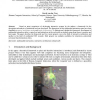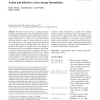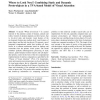543 search results - page 62 / 109 » A Theory of the Quasi-Static World |
101
click to vote
PUC
2007
14 years 10 months ago
2007
Based on many experiences of developing interactive systems by the authors, a framework for the description and analysis of interaction has been developed. The dimensions of this m...
PROCEDIA
2010
14 years 9 months ago
2010
Modern physical theory and modern computational techniques are used to provide conjecture on how nature computes. I utilize time-domain simulation of physical phenomena and build ...
BC
2010
14 years 8 months ago
2010
We have previously tried to explain perceptual inference and learning under a free-energy principle that pursues Helmholtz's agenda to understand the brain in terms of energy ...
104
click to vote
COGCOM
2010
14 years 8 months ago
2010
To decide ``Where to look next ?'' is a central function of the attention system of humans, animals and robots. Control of attention depends on three factors, that is, lo...
112
click to vote
WWW
2011
ACM
14 years 6 months ago
2011
ACM
The clustering coefficient of a node in a social network is a fundamental measure that quantifies how tightly-knit the community is around the node. Its computation can be reduce...



